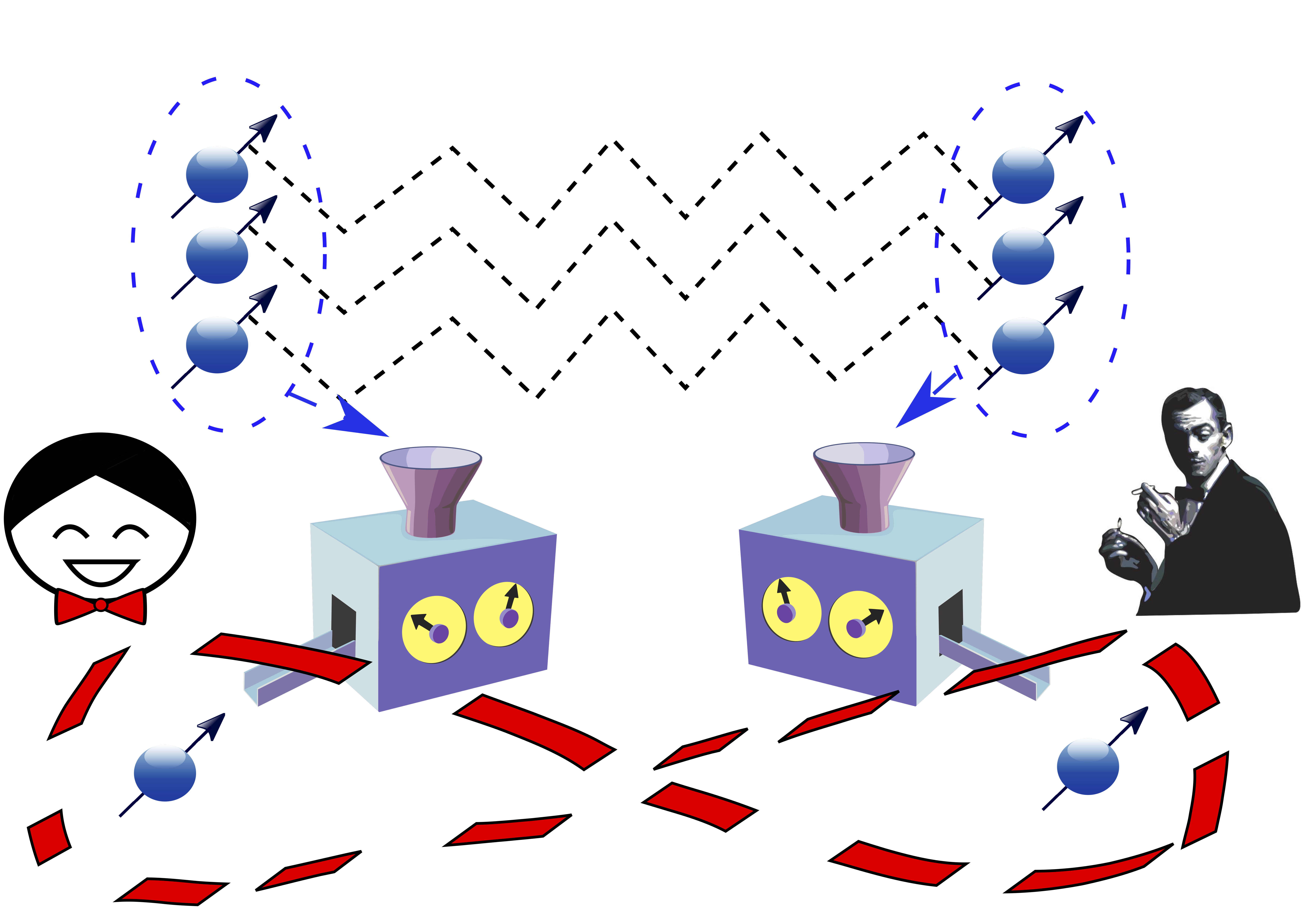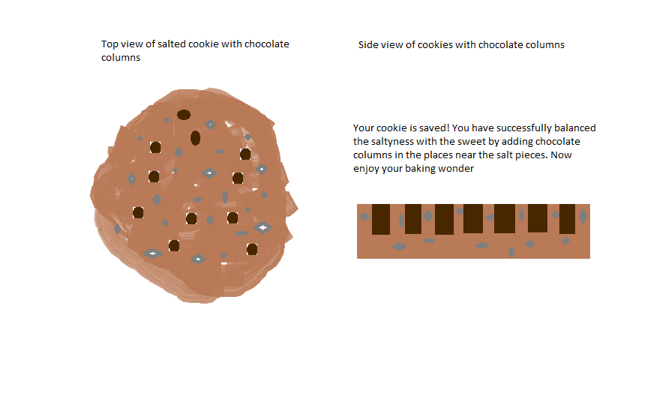02.10.2016difficulty level - QQQ
Entanglement distillation

by Filip Rozpedek
Entanglement, is it always pure?
You have probably already heard about entanglement. Entanglement is this fascinating phenomenon, in which two distant objects can manifest correlations, even if they are far far away from each other. You may have also heard that remote entanglement is a necessary ingredient for many quantum information processing tasks. For example, in quantum cryptography, two people who hold entangled particles can use those correlations to obtain shared secret keys, whose security is guaranteed by the laws of quantum mechanics. Today, we will not discuss how to use remote entanglement, but rather, what to do if our entanglement is too weak.
Unfortunately, fully entangled states which are perfectly correlated are a great idealization and from an experimental perspective almost impossible to create. In general, there can be many reasons for this, e.g. our experimental equipment isn’t perfect or we cannot maintain our quantum system long enough. All those things combined lead to various forms of contamination of the entanglement. That is, the correlations become weaker and completely diluted in a mixture of various other quantum states.
So what do we do with those so-called “partially entangled states”? Let us say that two parties working at QuTech, whom we call Alice and Bob, share those partially entangled states and would like to use them to generate shared secret keys. Let us also say that their experimental setup allows them to produce partially entangled states very fast, but the amount of entanglement in each of them is insufficient to generate shared secret keys. It is known from Quantum theory that it is not possible to increase the amount of entanglement in a given quantum state by only performing operations on the entangled particles locally and exchanging classical messages. It seems that there is no choice for Alice and Bob, but to go home without a key.
Entanglement is like alcohol, it is distillable
Fortunately, Alice and Bob have two friends (well maybe they have more, but this remains unknown), called Alessandro and Bruno, who are the experts on decoherence (as can be easily verified in this article). It turns out that Alessandro and Bruno have a special skill that could rescue Alice and Bob. Namely, they can perform distillation.

Alessandro and Bruno distill whisky at a distillery in Fort William in Scotland.
In Fort William, Alessandro and Bruno distill alcohol for the production of whisky. So what do Alessandro and Bruno exactly do? Well, they start with a form of beer that is stored in the massive stills as the ones on the picture. This beer is a mixture of pure alcohol (8-10%), water and some other substances.
For the high quality whisky Alessandro and Bruno need to extract this pure ethanol from everything else. Fortunately ethanol boils at around 78.5 degrees Celsius and so by heating the stills to this temperature, the alcohol can be evaporated. Later, the alcohol condenses outside of the stills and one is able to separate it from the “contamination” that shouldn’t end up in any high quality whisky. Well, this is a big approximation, because to separate alcohol from the water one requires to perform multiple rounds of distillation.
Alice and Bob became very interested in the work of Alessandro and Bruno because they started to suspect that entanglement is a bit like alcohol. Weakly entangled states are “contaminated”, but it may be possible to use the techniques of Alessandro and Bruno, to distill the entanglement out of the mixture of all those different quantum states. Hence, Alice and Bob invited Alessandro and Bruno to QuTech and asked them to apply their precious skill to their shared partially entangled states. You might be puzzled now. How will Alessandro and Bruno be performing entanglement distillation? Will they heat up the entangled particles? It’s a bit different.
In entanglement distillation Alice and Bob will use multiple copies of the partially entangled states. The hope of Alessandro and Bruno is that although each of these states has some, small amount of entanglement, it is possible to mix those copies together, and eliminate the contamination by extracting only the entangled part, so that at the end they obtain a single highly entangled state. Guided by their experience in Fort William, Alessandro and Bruno expect that for realistic procedures, a single run of such a distillation would not be enough. Similar to alcohol distillation, where the total amount of alcohol cannot be increased, entanglement can be concentrated into a smaller number of copies, using only local operations and classical communication, without increasing the total amount of entanglement. This shows that, unfortunately, Alessandro and Bruno are not superhuman and remain bounded by the laws of nature.
From two copies to one
Having absorbed these abstract concepts you might think: “What a story!”. To illustrate these methods we will focus on some simple examples. Alessandro and Bruno are very interested in protocols that can be implemented with current technology. Therefore they will not consider any operations for which Alice and Bob would need a large number of partially entangled states.

Alessandro and Bruno distill entanglement at QuTech. From multiple copies of weakly entangled states Alessandro and Bruno can obtain a single copy of maximally entangled state. (Figures of Alessandro, Bruno and the measuring device: courtesy of Dmytro Vasylyev and Nelly Ng)
Let us look at the methods of entanglement distillation applicable to small systems. Firstly, let’s say that Alice and Bob can only generate two-qubit states in their lab at QuTech. Specifically, there exist simple distillation procedures in which Alice and Bob perform simple local operations on two shared copies of partially entangled states. Those operations include a so-called controlled NOT gate. This quantum gate is very analogous to its classical counterpart. In the classical scenario depending on the value of the first bit, the second bit is flipped or not. Now in the quantum case our first “controlling bit” can be in superposition of 0 and 1, in which case in superposition we flip and not flip the second bit.

Illustration of the controlled NOT gate. Depending on the state of the first qubit, the second qubit gets flipped or not. The interesting quantum effects arise, when the first qubit is in superposition of [latex] 0\rangle [/latex] and [latex] |1\rangle [/latex].

Alice and Bob share two partially entangled states. They apply the controlled NOT gate locally to their particles. They measure both their second particles and compare the measurement outcome over the phone. If their outcomes were the same, then the first pair will have now more entanglement than it had before.
Can we just filter one copy?
Unfortunately, after careful examination of their experimental setup, Alice and Bob realize that they can only maintain one such state at a time. So the ability to concentrate entanglement from multiple copies into a single copy of the state is unfortunately of no use for them at the moment. We’ve said that it is not possible to increase the total amount of entanglement using only local operations and classical communication. Fortunately probabilistic procedures come to the rescue. There is nothing that forbids increasing entanglement only probabilistically, such that on average it does not increase. In fact there exist so called filtering protocols where by just performing a smart measurement on their single qubits, Alice and Bob can from one copy of some specific partially entangled states, obtain one more entangled copy, paying the cost of probabilistically ending up with nothing. Hence we see that Alessandro and Bruno can help Alice and Bob in their great endeavor so that Alice and Bob can go home with a (shared) key.
About Filip

Filip Rozpedek is a QuTech theorist.
His research is in the topic of quantum networks and quantum communication, where he looks for efficient ways of distributing quantum states and quantum entanglement over long distances.
He is specifically interested in schemes that can be realized with the current technology.
At work he enjoys counting bad jokes of his office colleagues.
Outside of QuTech he normally dresses up as illustrated on the picture and practices his Scottish Country Dancing skills.
